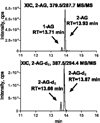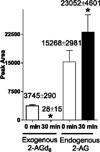Brain 2-Arachidonoylglycerol Levels Are Dramatically and Rapidly Increased Under Acute Ischemia-Injury Which Is Prevented by Microwave Irradiation
- PMID: 27021494
- PMCID: PMC4818708
- DOI: 10.1007/s11745-016-4144-y
Brain 2-Arachidonoylglycerol Levels Are Dramatically and Rapidly Increased Under Acute Ischemia-Injury Which Is Prevented by Microwave Irradiation
Abstract
The involvement of brain 2-arachidonoylglycerol (2-AG) in a number of critical physiological and pathophysiological regulatory mechanisms highlights the importance for an accurate brain 2-AG determination. In the present study, we validated head-focused microwave irradiation (MW) as a method to prevent postmortem brain 2-AG alterations before analysis. We compared MW to freezing to prevent 2-AG induction and estimated exogenous and endogenous 2-AG stability upon exposure to MW. Using MW, we measured, for the first time, true 2-AG brain levels under basal conditions, 30 s after brain removal from the cranium, and upon exposure to 5 min of brain global ischemia. Our data indicate that brain 2-AG levels are instantaneously and dramatically increased approximately 60-fold upon brain removal from the cranium. With 5 min of brain global ischemia 2-AG levels are also, but less dramatically, increased 3.5-fold. Our data indicate that brain tissue fixation with MW is a required technique to measure both true basal 2-AG levels and 2-AG alterations under different experimental conditions including global ischemia, and 2-AG is stable upon exposure to MW.
Keywords: 2-Arachidonoylglycerol; Analysis; Brain; Endocannabinoids; Injury; Ischemia; Mass spectrometry; Microwave; Stroke.
Conflict of interest statement
The authors declare that the research was conducted in the absence of any commercial or financial relationships that could be construed as a potential conflict of interest.
Figures




References
-
- Hohmann AG, Suplita RL, Bolton NM, Neely MH, Fegley D, Mangieri R, Krey JF, Walker JM, Holmes PV, Crystal JD, Duranti A, Tontini A, Mor M, Tarzia G, Piomelli D. An endocannabinoid mechanism for stress-induced analgesia. Nature. 2005;435:1108–1112. - PubMed
-
- Kreitzer AC, Malenka RC. Endocannabinoid-mediated rescue of striatal LTD and motor deficits in Parkinson's disease models. Nature. 2007;445:643–647. - PubMed
Publication types
MeSH terms
Substances
Grants and funding
LinkOut - more resources
Full Text Sources
Other Literature Sources

